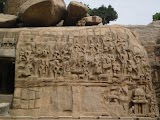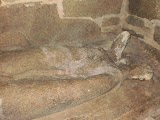India has always been considered a religiously prosperous
country. She can boast of a number of
sacred cities like Ayodhya, Hastinapur,
Varanasi, Ujjain etc. Out of which Hastinapur holds a special mention.
Three out of the 24 Tithankars of Jainism namely, 16th
Tirthankar Shri Shantinath, 17th Tirthankar Shri Kunthunath and 18th
Tirthankar Shri Arahnath were born at Hastinapur. Hastinapur was considered as
the capital of India during the time of Mahabharat.
Hastinapur falls under
Meerut district and is 40kms from it and 110 kms from the capital city Delhi.
There is a regular bus service between Delhi and Hastinapur from ISBT and Anand
Vihar bus stand. Regular roadways buses also ply between Meerut and Hastinapur.
Jambudweep – A Jain Temple in Hastinapur
The foundation stone of Jambudweep was laid in July 1974. It
had been especially designed under the direction of Supreme Jain Sadhvi Param
Pujya 105 Ganini Pramukh Aryika Shiromani Shri Gyanmati Mataji.
The structure of Jambudweep depicting, Jain Geography, is a
model of our universe. Centrally located SUMERU MOUNTAIN is the focal point.
According to Jain and Vedic scriptures, SUMERU MOUNTAIN is considered the most
sacred and highest mountain in the whole universe. Around it Jambudweep is
divided into four distinct regions EAST, WEST, NORTH and SOUTH. The EAST region
is known as EAST VIDEH KSHETRA while WEST region is known as WEST VIDEH
KSHETRA. SOUTH region is known as BHARAT KSHETRA having Himvan mountains,
Ganga-Sindhu rivers, Bhogbhumis (lands of enjoyment) with Kalpvrikshas(wish
fulfilling trees), Chaityalayas(temples), palaces of deities, ponds, gardens
etc. NORTH region has prominence of Airavat Kshetra. There are 78 natural or
Akritrim temples, 122 temples of deity-palaces and 6 Samavsaran temples in Jambudweep
surrounded by Lavan Samudra, in which pilgrims enjoy boating. Pilgrims also
enjoy breath taking sight of evening lights and colourful fountains.
Various Temples with High Summits At Jambudweep Campus
The campus is dotted with different temples named as Kamal Mandir, Teen Murti Mandir, Shantinath Mandir, Om Mandir, Adinath Mandir, Navgrah Mandir,Shastrakoot Jinalaya, Existing 20 Tirthankar Mandir, Rishabdev Kirtistambh, Meditation Temple,Ashtapad Mandir and Teeahdweep Jinalaya
 |
Teen Murti MandirLotus TempleAshtapad MandirInside view of Ashtapad MandirTeen Lok Rachana
Another marvellous structure at the campus. It consists of Adlok(7 hells), Madhyalok(with islands and oceans) and Urdhvalok(16 heavens alongwith graiveyaks,Anudishs, Anuttars and Siddhashila) on top. Electic lift takes the visitor to the top in few seconds.
Means Of Recreation
Tourists can enjoy various recreational facilities available to them such as exhibitions related to history of Hastinapur, fountains of laughter, Jambudweep train, Tomato train, various swings, Columbus etc. A special celebration named JAMBUDWEEPMAHA-MAHOTSAVA is organized every 5th year
Facilities For Pilgrims
Pilgrims visiting Jambudweep can avail of 250 rooms with modern facilities, more than 50 deluxe flats and a number of guest houses for their convenient stay. There is RAJA SHREYANS BHOJNALAYA where pilgrims are served with pure and delicious meals.
|




.jpg)


















